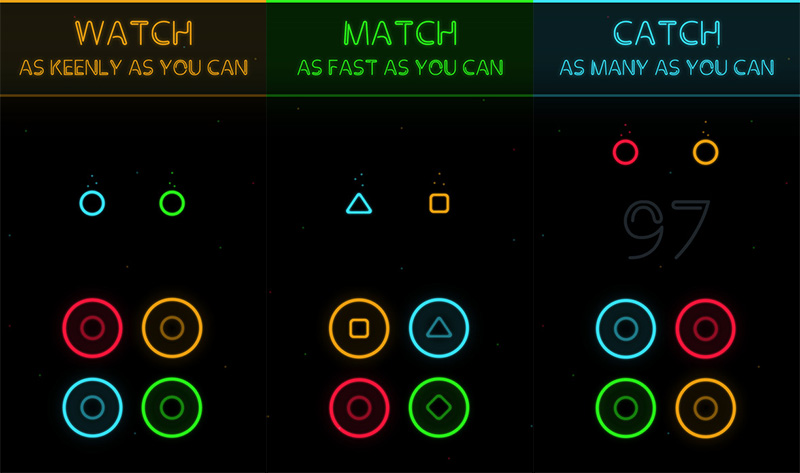Create a HTML5 game like “Pudi” using Phaser – Match games meet Tetris
Talking about Pudi game, Game development, HTML5, Javascript and Phaser.
Learn cross platform HTML5 game development
Check my Gumroad page for commented source code, games and books.
 To make them match, you have two ways to control the four big circles: with a double tap, you switch the upper circles. With a vertical swipe, you rotate all the circles, clockwise or counter-clockwise according to swipe direction and position. Same thing for the horizontal swipe, although the game should be played mostly with double taps and vertical swipes.
In this first part of the series, we’ll see how to create the player interaction with the game:
Double tap/click to switch the upper big circles, swipe to rotate all circles.
Everything has been made in less than 100 lines, still uncommented because it’s just the first prototype, but you’ll have the usual line-by-line comments once the game is completed
To make them match, you have two ways to control the four big circles: with a double tap, you switch the upper circles. With a vertical swipe, you rotate all the circles, clockwise or counter-clockwise according to swipe direction and position. Same thing for the horizontal swipe, although the game should be played mostly with double taps and vertical swipes.
In this first part of the series, we’ll see how to create the player interaction with the game:
Double tap/click to switch the upper big circles, swipe to rotate all circles.
Everything has been made in less than 100 lines, still uncommented because it’s just the first prototype, but you’ll have the usual line-by-line comments once the game is completed
var game;
var gameOptions = {
gameWidth: 500,
gameHeight: 500,
circleColors: [0xfe153a, 0x36dffa, 0xec9f10, 0x27f118],
circlePositions: [new Phaser.Point(-125, -125), new Phaser.Point(125, -125), new Phaser.Point(125, 125), new Phaser.Point(-125, 125)]
}
var SWIPEUP = 0;
var SWIPEDOWN = 1;
var SWIPELEFT = 2;
var SWIPERIGHT = 3;
window.onload = function() {
game = new Phaser.Game(gameOptions.gameWidth, gameOptions.gameHeight);
game.state.add("PlayGame", playGame);
game.state.start("PlayGame");
}
var playGame = function(game){}
playGame.prototype = {
preload: function(){
game.load.image("circle", "circle.png");
},
create: function(){
game.stage.backgroundColor = 0x444444;
this.circleGroup = game.add.group();
this.circleGroup.position.set(game.width / 2, game.height / 2);
this.circlesArray = [];
for(var i = 0; i < 4; i++){
var circle = game.add.sprite(gameOptions.circlePositions[i].x, gameOptions.circlePositions[i].y, "circle");
circle.anchor.set(0.5);
circle.tint = gameOptions.circleColors[i];
this.circlesArray.push(circle);
this.circleGroup.add(circle);
}
game.input.onTap.add(this.handleTap, this);
game.input.onDown.add(this.beginSwipe, this);
},
handleTap: function(pointer, doubleTap){
if(doubleTap){
var tweenRight = game.add.tween(this.circlesArray[0]).to({
x: this.circlesArray[0].x + 250
}, 200, Phaser.Easing.Cubic.Out, true);
var tweenLeft = game.add.tween(this.circlesArray[1]).to({
x: this.circlesArray[1].x - 250
}, 200, Phaser.Easing.Cubic.Out, true);
var tempSprite = this.circlesArray[0];
this.circlesArray[0] = this.circlesArray[1];
this.circlesArray[1] = tempSprite;
}
},
beginSwipe: function(e) {
game.input.onDown.remove(this.beginSwipe, this);
game.input.onUp.add(this.endSwipe, this);
},
endSwipe: function(e) {
game.input.onUp.remove(this.endSwipe, this);
var swipeTime = e.timeUp - e.timeDown;
var swipeDistance = Phaser.Point.subtract(e.position, e.positionDown);
var swipeMagnitude = swipeDistance.getMagnitude();
var swipeNormal = Phaser.Point.normalize(swipeDistance);
if(swipeMagnitude > 20 && swipeTime < 1000 && (Math.abs(swipeNormal.y) > 0.8 || Math.abs(swipeNormal.x) > 0.8)) {
if(swipeNormal.x > 0.8) {
this.handleSwipe(SWIPERIGHT, e.position);
}
if(swipeNormal.x < -0.8) {
this.handleSwipe(SWIPELEFT, e.position);
}
if(swipeNormal.y > 0.8) {
this.handleSwipe(SWIPEDOWN, e.position);
}
if(swipeNormal.y < -0.8) {
this.handleSwipe(SWIPEUP, e.position);
}
} else {
game.input.onDown.add(this.beginSwipe, this);
}
},
handleSwipe: function(dir, startPoint) {
var degrees = ((dir == SWIPERIGHT) || (dir == SWIPEUP && startPoint.x < game.width / 2) || (dir == SWIPEDOWN && startPoint.x > game.width / 2)) ? 90 : -90;
var rotateTween = game.add.tween(this.circleGroup).to({
angle: degrees
}, 200, Phaser.Easing.Cubic.Out, true);
rotateTween.onComplete.add(function(){
if(degrees == 90){
Phaser.ArrayUtils.rotateRight(this.circlesArray);
}
else{
Phaser.ArrayUtils.rotateLeft(this.circlesArray);
}
this.circleGroup.angle = 0;
for(var i = 0; i < 4; i++){
this.circlesArray[i].position.set(gameOptions.circlePositions[i].x, gameOptions.circlePositions[i].y);
}
}, this);
game.input.onDown.add(this.beginSwipe, this);
}
}
game.input.onTap.add(this.handleTap, this);
I am using the onTap event which also allows me to detect double taps.
Download the source code and have fun. Never miss an update! Subscribe, and I will bother you by email only when a new game or full source code comes out.
